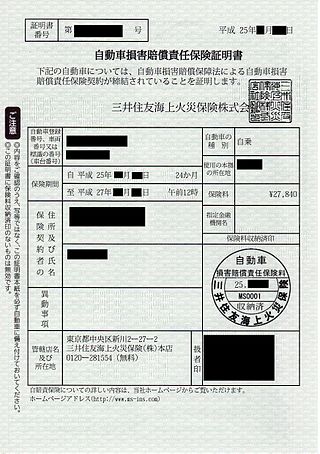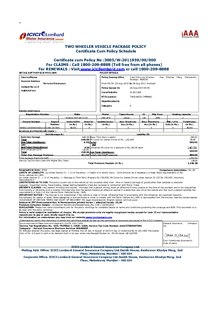
Insurance is a means of protection from financial loss in which, in exchange for a fee, a party agrees to compensate another party in the event of a certain loss, damage, or injury. It is a form of risk management, primarily used to protect against the risk of a contingent or uncertain loss.

Life insurance is a contract between an insurance policy holder and an insurer or assurer, where the insurer promises to pay a designated beneficiary a sum of money upon the death of an insured person. Depending on the contract, other events such as terminal illness or critical illness can also trigger payment. The policyholder typically pays a premium, either regularly or as one lump sum. The benefits may include other expenses, such as funeral expenses.

Vehicle insurance is insurance for cars, trucks, motorcycles, and other road vehicles. Its primary use is to provide financial protection against physical damage or bodily injury resulting from traffic collisions and against liability that could also arise from incidents in a vehicle. Vehicle insurance may additionally offer financial protection against theft of the vehicle, and against damage to the vehicle sustained from events other than traffic collisions, such as vandalism, weather or natural disasters, and damage sustained by colliding with stationary objects. The specific terms of vehicle insurance vary with legal regulations in each region.
In an insurance policy, the deductible is the amount paid out of pocket by the policy holder before an insurance provider will pay any expenses. In general usage, the term deductible may be used to describe one of several types of clauses that are used by insurance companies as a threshold for policy payments.
Home insurance, also commonly called homeowner's insurance, is a type of property insurance that covers a private residence. It is an insurance policy that combines various personal insurance protections, which can include losses occurring to one's home, its contents, loss of use, or loss of other personal possessions of the homeowner, as well as liability insurance for accidents that may happen at the home or at the hands of the homeowner within the policy territory.
Insurance fraud refers to any intentional act committed to deceive or mislead an insurance company during the application or claims process, or the wrongful denial of a legitimate claim by an insurance company. It occurs when a claimant knowingly attempts to obtain a benefit or advantage they are not entitled to receive, or when an insurer knowingly denies a benefit or advantage that is due to the insured. According to the United States Federal Bureau of Investigation, the most common schemes include premium diversion, fee churning, asset diversion, and workers compensation fraud. False insurance claims are insurance claims filed with the fraudulent intention towards an insurance provider.

General insurance or non-life insurance policy, including automobile and homeowners policies, provide payments depending on the loss from a particular financial event. General insurance is typically defined as any insurance that is not determined to be life insurance. It is called property and casualty insurance in the United States and Canada and non-life insurance in Continental Europe.
Liability insurance is a part of the general insurance system of risk financing to protect the purchaser from the risks of liabilities imposed by lawsuits and similar claims and protects the insured if the purchaser is sued for claims that come within the coverage of the insurance policy.
Protection and indemnity insurance, more commonly known as P&I insurance, is a form of mutual maritime insurance provided by a P&I club. Whereas a marine insurance company provides "hull and machinery" cover for shipowners, and cargo cover for cargo owners, a P&I club provides cover for open-ended risks that traditional insurers are reluctant to insure. Typical P&I cover includes: a carrier's third-party risks for damage caused to cargo during carriage; war risks; and risks of environmental damage such as oil spills and pollution. In the UK, both traditional underwriters and P&I clubs are subject to the Marine Insurance Act 1906.

Aviation insurance is insurance coverage geared specifically to the operation of aircraft and the risks involved in aviation. Aviation insurance policies are distinctly different from those for other areas of transportation and tend to incorporate aviation terminology, as well as terminology, limits and clauses specific to aviation insurance.

The Motor Insurers' Bureau (MIB) was founded in the UK in 1946 as a private company limited by guarantee and is the mechanism in the UK through which compensation is provided for victims of accidents caused by uninsured and untraced drivers, which is funded by an estimated £30 a year from every insured driver's premiums.
Expatriate insurance are insurance policies that are designed to cover financial and other risks incurred specifically by expatriates while living and working in a country other than one's own. The insurances that expatriates need are similar to individuals living in the country but may be more complex to arrange because they are not native. There may also be specific risks for high-risk areas of the world where specialty insurance can provide coverage for war and terrorism, kidnap and ransom.
Satellite insurance is a specialized branch of aviation insurance in which, as of 2000, about 20 insurers worldwide participate directly. Others participate through reinsurance contracts with direct providers. It covers three risks: relaunching the satellite if the launch operation fails; replacing the satellite if it is destroyed, positioned in an improper orbit, or fails in orbit; and liability for damage to third parties caused by the satellite or the launch vehicle.
Legal protection insurance (LPI), also known as legal expenses insurance (LEI) or simply legal insurance, is a particular class of insurance which facilitates access to law and justice by providing legal advice and covering the legal costs of a dispute, regardless of whether the case is brought by or against the policyholder. Depending on the national rules, legal protection insurers can also represent the policyholder out-of-court or even in-court.

Lister v Romford Ice and Cold Storage Co Ltd[1956] UKHL 6 is an important English tort law, contract law and labour law, which concerns vicarious liability and an ostensible duty of an employee to compensate the employer for torts he commits in the course of employment.
Vehicle insurance in the United States is designed to cover the risk of financial liability or the loss of a motor vehicle that the owner may face if their vehicle is involved in a collision that results in property or physical damage. Most states require a motor vehicle owner to carry some minimum level of liability insurance. States that do not require the vehicle owner to carry car insurance include New Hampshire and Mississippi, which offers vehicle owners the option to post cash bonds. The privileges and immunities clause of Article IV of the U.S. Constitution protects the rights of citizens in each respective state when traveling to another. A motor vehicle owner typically pays insurers a monthly or yearly fee, often called an insurance premium. The insurance premium a motor vehicle owner pays is usually determined by a variety of factors including the type of covered vehicle, marital status, credit score, whether the driver rents or owns a home, the age and gender of any covered drivers, their driving history, and the location where the vehicle is primarily driven and stored. Most insurance companies will increase insurance premium rates based on these factors and offer discounts less frequently.
Insurance in South Africa describes a mechanism in that country for the reduction or minimisation of loss, owing to the constant exposure of people and assets to risks. The kinds of loss which arise if such risks eventuate may be either patrimonial or non-patrimonial.

The Ontario Automobile Policy is a regulation under the Ontario Insurance Act enacted by the Parliament of Ontario to cover financial damages to persons and property after a car crash. All private companies registered to sell auto insurance in Ontario, are required to use the OAP for their private car insurance policy. The OAP is the legal contract that connects an Ontario driver with every Ontario based insurance company.

Vehicle insurance in France is an compensation-based insurance policy for terrestrial motor vehicles that are insured in France and circulate on French territory, as well as in the European Economic Area and the Green Card zone.
In 1930, the UK Government introduced a law that required every person who used a vehicle on the road to have at least third-party personal injury insurance. Today, this law is contained in the Road Traffic Act 1988. Section 143 of that Act requires that motorists be insured against liability for injuries to others and for damage to other persons' property, resulting from use of a vehicle on a public road or in other public places.









